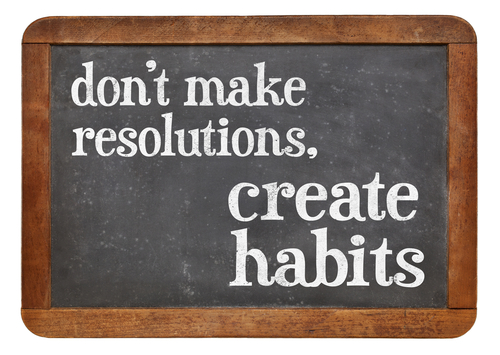The habits we have are the predictors of so much of what we achieve in our lives. Our parents model habits and we unconsciously adopt them.
Everyday I focus on helping individuals create new habits (including myself) that will empower them towards their goals and realising their potential.
A Spanish proverb says, “Habits are at first spider-webs then cablesâ€.
Habits are like compounding interest. Success doesn’t come overnight. On the contrary, it’s habits, not discipline that gets you from Point A to the often-elusive Point B.Â
“We are what we repeatedly do. Excellence then, is not an act, but a habit.â€Â Aristotle.
You already have a lot of habits, some which are serving you well and others that are probably hindering your effectiveness as a person and leader.
In my work with leaders some of the most common habits they see are hindering their effectiveness:
- Organisation of themselves
- Not listening or being present
- Delegating poorly, doing it themselves
- Irregular supervision with staff
- Getting caught in tactical activities too oftenÂ
HOW DO WE CREATE NEW HABITS (REALLY)?
In our day-to-day lives, habits can often be tough to create. There are plenty of interferences that can lead us off the “straight and narrow†and right back to our old ways.
There’s a lot of garbage about building habits out there, the most common and probably least accurate being “do something for 21 days and you build a new habit.â€
When we first engage in a new task, our brains are working hard—processing tons of new information as we find our way. But, as soon as we understand how a task works, the behaviour starts becoming automatic and the mental activity required to do the task decreases dramatically.
Think about how much brainpower and concentration you had to use the first time you parallel parked or even the first time you tied your shoelaces. Then compare that to the amount of mental effort you exert doing those activities now.
In the Power of Habit, written by Charles Duhigg; “This process—in which the brain converts a sequence of actions into an automatic routine—is known as “chunking,†and it’s at the root of how habits form. There are dozens—if not hundreds—of behavioural chunks that we rely on every day.â€
The good news is that in the last few years, there has been some deeply practical work done on what actually builds habits, based on research and neuroscience.
 5 KEYS TO BUILDING NEW HABITS
1. Make “minimum quotas†within “big goalsâ€
In the most basic sense, “dreaming big†is pretty good advice after all to create new habits, according to various researchers. Creating big picture clarity about what you want to do, be, or have is vital to shift habits. Big goals help to create intrinsic motivation (being motivated to do things internally, not through punishments or rewards) which is an essential part of building habits that stick.
You need to find a way to balance this desire to dream big with your day-to-day activities.
The answer is to create “minimum quotasâ€Â within “big goals.†Your goals should be the big picture items that you wish to someday accomplish, but your quotas, are the minimum amounts of work that you must get done every single day to make the bigger goal a reality. Quotas make each day approachable, and your goals become achievable because of this.
For instance, if you are a writer it might be a minimum number of words per day. If you are a teacher, a minimum number of hours per week in learning new concepts. If you are a team leader, a minimum number contacts with each of your team members.
2. Create behaviour chains
Habits consist of a simple, but extremely powerful, three-step loop. Here’s Duhigg again:
“First, there is a cue, a trigger that tells your brain to go into automatic mode and which habit to use. Then there is the routine, which can be physical or mental or emotional. Finally, there is a reward, which helps your brain figure out if this particular loop is worth remembering for the future. Over time, this loop… becomes more and more automatic. The cue and reward become intertwined until a powerful sense of anticipation and craving emerges.â€
How to Change a Habit?
The first rule of habit-changing is that you have to play by the rules. That is, there’s no escaping the three-step loop (e.g. cue, routine, reward) because it’s hard-wired into our brains.
If you want to get rid of a bad habit, you have to find out how to implement a healthier routine to yield the same reward.
Creating sticky habits is far easier when we make use of our current routines, instead of trying to fight them. The concept of if-then planning is built around environmental “triggers†that we can use to let us know that it’s time to act on our habit.
Pick a regular part of your schedule and then building another “link in the chain†by adding a new habit.
For instance, one client wanted to create regular habit of studying more during the week to progress in their profession. They noticed that when they studied they would make a cup of tea only when they studied. After dinner they decided to make a cup of tea instead of watching TV. Building this familiar trigger’ into the chain created a new habit – studying more often.
How effective are these plans?
One study looked at people who had the goal of becoming regular exercisers. Half the participants were asked to plan where and when they would exercise each week (e.g., “If it is Monday, Wednesday, or Friday, then I will hit the gym for an hour before work.â€) The results were dramatic: months later, 91% of if-then planners were still exercising regularly, compared to only 39% of non-planners!
A recent review of results from 94 studies that used the if-then technique found significantly higher success rates for just about every goal you can think of, including test preparation, using public transportation instead of driving, buying organic foods, being more helpful to others, not drinking alcohol, not starting smoking, losing weight, recycling, negotiating fairly, avoiding stereotypic and prejudicial thoughts, and better time management.
For instance, instead of “I will keep my desk cleanerâ€, you could aim for, “When I pack my bag to go home, then I’ll clear my deskâ€. Or, “I will make time to mentor my team.†When we have our team then I’ll make 30 minutes to have a one-on-one meetings.â€
3. Eliminate excessive options
According to a variety of research on self-control  —and expounded upon in books like The Willpower Effect — there is great power in being boring and predictable. Take, for instance, Barack Obama’s insistence on never wearing anything but blue and grey suits. According to the president, “I’m trying to pare down decisions. I don’t want to make too many decisions about what I’m eating or wearing. Because I have too many other decisions to make.â€
The president’s belief is well supported by the research of Kathleen Vohs study on self-control. She found that making repeated choices depleted the mental energy of people, even if those choices were mundane and relatively pleasant. According to the Harvard Business Review, if you want to maintain long-term discipline, it’s best to “Identify the aspects of your life that you consider mundane — and then routinize’ those aspects as much as possible. In short, make fewer decisions.â€
For lasting change, the steps you take must ultimately change your environment and schedule. Stop buying snacks if you want to stop snacking (no willpower needed), pack a very similar lunch every day of the week, and embrace the power of routine to get the necessary done each day.
4. Eliminate “ah-I-can’t-be-be botheredâ€
New habits are often very fragile, and it is for this reason that we must eliminate any source of friction that may lead us astray. These “ah-I-can’t-be-bothered†moments are the specific moments where you find yourself saying, “Screw this, it’s not worth the effort!†A more scientific take on this phenomenon is called the What the Hell Effect, which explains why we are so likely to abandon ship with a new habit at the first slip-up.
The solution? Examine your habit and find exactly where things start to break down. Once you have identified the break down point, avoid it, call in help from someone to help you in those moments.
5. Create Micro-Habits
BJ Fogg, an academic at Stanford where he is Director of the Persuasive Technology Lab and is also creator of the TinyHabits.com website.
BJ has focused deeply on how to change human behaviour, and one of his most powerful contributions is a simple solution to how we can stop sabotaging our own best efforts to build new habits.
His insight is that as soon as we create a broad habit – let’s say, going for a run in the morning – our big brains immediately start finding ways to “hack†our well-meaning plan. It doesn’t take much, as you’re lying in your warm bed, to think of all those excellent reasons why today (just today, tomorrow I’ll be good I promise) you can’t go for that run.
Fogg says that the secret is to define a first step that takes less than 60 seconds to do.
What Fogg is telling us is that we need to define the first step – the micro-habit – of the larger habit we want to build.
Don’t try to build a habit to go for a run in the morning. Build a habit to put on your running shoes as soon as you get out of bed. When someone comes into your office, instead of getting sucked into a conversation and getting sidetracked, suggest a time to meet later on. Should take less than 60 seconds. When you get into your office, instead of reading your email, take 60 seconds to plan your day.
Let me know if you have implemented any of these tips and how it has helped you.

